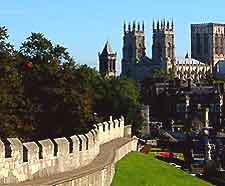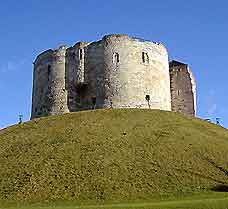York History Facts and Timeline
(York, North Yorkshire, England)

York's history is said to have begun with the arrival of the Romans in 71 AD. A group of 5,000 soldiers set up camp here, quickly understanding the strategic importance of the site. Thus, Eboracum was born.
After the departure of the Romans in the 5th century AD, it's likely that the city became a power base for Anglo-Saxon leaders. Certainly, by 600 AD, the settlement at York, known then as Eoforwic, was a place of some significance. The Roman gates were preserved and new streets added during this period of the city's history. Then, in the early 7th century, Pope Gregory chose York to be the centre of the Christian church in the north of England. He sent his missionary, Bishop Paulinus, and in 627 AD, a small wooden church was built and dedicated to St. Peter.
From the Vikings to the Middle Ages
In 866 AD, a Viking army attacked and took York. Over the course of the next two years, there were more violent clashes. Finally, King Alfred of Wessex agreed a truce and England was divided into two - the southern Anglo-Saxon kingdom and the northern Danelaw. Henceforth, the city was known as Jorvik. The Vikings were keen traders and very soon, Jorvik became a lively marketplace for goods that were imported from all over the world.
In 954 AD, the last Viking ruler Eric Bloodaxe was defeated and York again became an Anglo-Saxon city. This was a relatively peaceful time during which the city prospered. By the time the Normans arrived, the city was second in size and wealth only to London. Convinced that northern unrest still lingered, William the Conqueror built two castles here, one at Clifford's Tower and the other at Baille Hill. He was quite right - in 1069, local forces attacked, although their victory wasn't to last very long. In revenge, William wreaked devastation in the north, using York as his base. Finally, with peace restored, the Norman reconstruction began. The Norman legacy includes around 40 churches and the new York Minister, which was finished in 1100.
During the Middle Ages, York enjoyed something of a golden era, boasting close ties with royalty. However, as the 15th century drew to a close, the city found itself losing ground. It was suffering from an economic decline, and what's more, it was on the losing side of the War of the Roses.

History from the Tudors to the 18th Century
The city's troubles only seemed to get worse under the Tudors. With its wealth reduced, York could no longer pay its taxes. Then, a royal charter took away the voting rights previously held by its inhabitants. Henry VIII's religious revolution, which was felt more heavily here than most places, must have seemed like the last straw.
In 1644, during the English Civil War, York was besieged by Parliamentarian forces. The city surrendered and, in so doing, managed to save many of its historic buildings from destruction, including its beloved Minster.
In the 18th century, York enjoyed a period of growth and relative prosperity. In 1730, the city's Assembly Rooms were built. It's at this time that the legend of Dick Turpin was born. This notorious highwayman was held in prison in the city before his execution.
Modern Times
During the Victorian era, York became a real railway town. The boom of this new form of transport helped to transform the city into a place of industry. It also opened it up to tourism. In 1877, the Royal Station Hotel was built to accommodate the many travellers that now came here by train.
Thankfully, history saw many buildings survive the Baedeker Blitz campaign of World War Two. Today, York remains one of the most historic cities in Britain and a popular destination for tourists.
 York's history is said to have begun with the arrival of the Romans in 71 AD. A group of 5,000 soldiers set up camp here, quickly understanding the strategic importance of the site. Thus, Eboracum was born.
York's history is said to have begun with the arrival of the Romans in 71 AD. A group of 5,000 soldiers set up camp here, quickly understanding the strategic importance of the site. Thus, Eboracum was born.